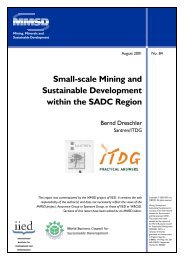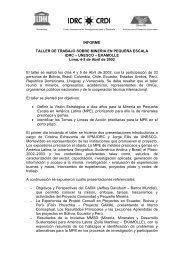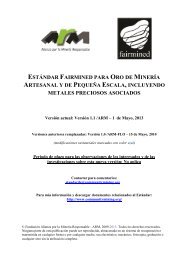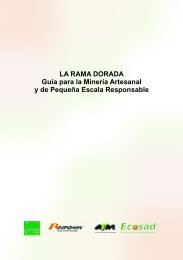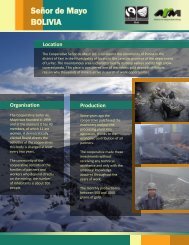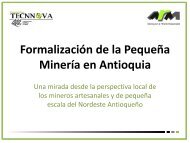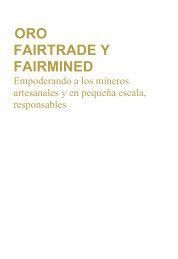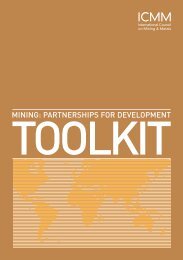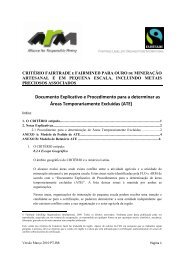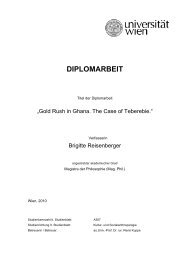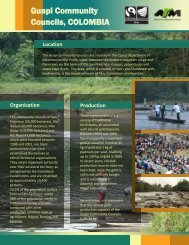A Poisonous Mix - Human Rights Watch
A Poisonous Mix - Human Rights Watch
A Poisonous Mix - Human Rights Watch
Create successful ePaper yourself
Turn your PDF publications into a flip-book with our unique Google optimized e-Paper software.
mine from 9 a.m. to 7 p.m., and that his joints hurt him at night. 167 Some children said they<br />
took lunch breaks or rested for a moment when they felt exhausted or in pain. 168<br />
Artisanal mines usually have one day of rest per week for everyone, including children.<br />
This is thought of as a day for the spirits of mining. 169<br />
Some child laborers attend school, but work full days in gold mining during holidays and<br />
weekends. They sometimes also work at the mines after school or skip lessons to go the<br />
mines. 170 Of 33 child miners interviewed, 16 went to school. Most of these children were<br />
younger and attended primary school. One child laborer who attends school was 12-yearold<br />
Issa S., who complained the impact of long work hours on his health:<br />
I work here with my father. I pull up the buckets with ore. It is ore mixed<br />
with water. During school holidays, I am here every day from 7am to 6.30pm,<br />
except Monday [rest day]…. I started working here when I was 10. My job<br />
has always been to pull the buckets up…. I have backaches from the heavy<br />
loads, on the lower back. It is really heavy. I would really like to stop. I don’t<br />
have a break apart from lunch break. 171<br />
Pay<br />
Children who work in artisanal mines are often not paid. If they do get paid, they give most<br />
of the money to their parents or guardians; adolescents who are by themselves often send<br />
money to their parents. When children work for people other than their parents, they face<br />
an additional risk of abuse and exploitation.<br />
Children’s Economic Contribution towards Their Own Family<br />
Many children contribute to the production process but do not obtain the gold at the end<br />
of it. Their work is considered part of a group work product. 172<br />
167 <strong>Human</strong> <strong>Rights</strong> <strong>Watch</strong> interview with Haroun C., age 12, Tabakoto, April 2, 2011.<br />
168 <strong>Human</strong> <strong>Rights</strong> <strong>Watch</strong> interview with Djibril C., age 15, Worognan, April 8, 2011; <strong>Human</strong> <strong>Rights</strong> <strong>Watch</strong> interview with<br />
Susanne D., 11, Worognan, April 8, 2011.<br />
169 ILO, “Etude transfrontalière sur le travail des enfants dans l’orpaillage,” p. 39; <strong>Human</strong> <strong>Rights</strong> <strong>Watch</strong> interview with<br />
representative of RAC, Kéniéba, April 2, 2011.<br />
170 <strong>Human</strong> <strong>Rights</strong> <strong>Watch</strong> interview with Nanfadima A., estimated age 11, Tabokoto, April 2, 2011; <strong>Human</strong> <strong>Rights</strong> <strong>Watch</strong><br />
interview with seven women gold miners, Sensoko, April 4, 2011; <strong>Human</strong> <strong>Rights</strong> <strong>Watch</strong> interview with school director,<br />
Worognan, April 8, 2011.<br />
171 <strong>Human</strong> <strong>Rights</strong> <strong>Watch</strong> interview with Issa S., age 12, Tabakoto, April 2, 2011.<br />
172 The ILO study found that 55 percent of children working with their family are not paid. ILO, “Etude transfrontalière sur le<br />
travail des enfants dans l’orpaillage,” p. 55. The study looked at the situation of children working with their parents and<br />
those living and working with other persons.<br />
A POISONOUS MIX 42



